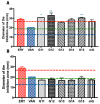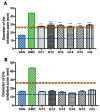In Vitro Antimicrobial Potential of Portuguese Propolis Extracts from Gerês against Pathogenic Microorganisms
- PMID: 39061337
- PMCID: PMC11273468
- DOI: 10.3390/antibiotics13070655
In Vitro Antimicrobial Potential of Portuguese Propolis Extracts from Gerês against Pathogenic Microorganisms
Abstract
Antimicrobial resistance (AMR) is one of humanity's main health problems today. Despite all the breakthroughs and research over the past few years, the number of microbial illnesses that are resistant to the available antibiotics is increasing at an alarming rate. In this article, we estimated the biomedical potential of Portuguese propolis harvested from the Gerês apiary over five years, evaluating the in vitro antimicrobial effect of five hydroalcoholic extracts prepared from five single propolis samples and of a hydroalcoholic extract obtained from the mixture of all samples. The antimicrobial potential was firstly assessed by determining the minimum inhibitory concentration (MIC) of these extracts against a panel of three Gram-positive (Bacillus subtilis, methicillin-sensitive Staphylococcus aureus, and methicillin-resistant Staphylococcus aureus) and one Gram-negative bacteria (Escherichia coli), as well as two yeasts (Candida albicans and Saccharomyces cerevisiae). As MIC values against each bacterium were consistent across all the evaluated propolis extracts, we decided to further conduct a disk diffusion assay, which included three commercial antibiotics-erythromycin, vancomycin, and amoxicillin/clavulanic acid-for comparison purposes. In addition to displaying a concentration-dependent antibacterial effect, the hydroalcoholic extracts prepared with 70% ethanol exhibited stronger antimicrobial capacity than vancomycin against B. subtilis (% of increase ranged between 26 and 59%) and methicillin-sensitive S. aureus (% of increase ranged between 63 and 77%). Moreover, methicillin-resistant S. aureus (MRSA) showed susceptibility to the activity of the same extracts and resistance to all tested antibiotics. These findings support that propolis from Gerês is a promising natural product with promising antimicrobial activity, representing a very stimulating result considering the actual problem with AMR.
Keywords: Portuguese propolis; antibiotic resistance; antimicrobial activity; pathogenic microorganisms.
Conflict of interest statement
The authors declare that there are no conflicts of interest.
Figures




Similar articles
-
[Antimicrobial activity of soft and purified propolis extracts].Medicina (Kaunas). 2008;44(12):977-83. Medicina (Kaunas). 2008. PMID: 19142056 Lithuanian.
-
Propolis Efficacy: The Quest for Eco-Friendly Solvents.Molecules. 2022 Nov 3;27(21):7531. doi: 10.3390/molecules27217531. Molecules. 2022. PMID: 36364353 Free PMC article.
-
Propolis antibacterial and antioxidant synergisms with gentamicin and honey.J Appl Microbiol. 2022 Apr;132(4):2733-2745. doi: 10.1111/jam.15440. Epub 2022 Feb 2. J Appl Microbiol. 2022. PMID: 35092131
-
Propolis characterization and antimicrobial activities against Staphylococcus aureus and Candida albicans: A review.Saudi J Biol Sci. 2022 Apr;29(4):1936-1946. doi: 10.1016/j.sjbs.2021.11.063. Epub 2021 Dec 3. Saudi J Biol Sci. 2022. PMID: 35531223 Free PMC article. Review.
-
Methicillin-resistant Staphylococcus aureus (MRSA) and anti-MRSA activities of extracts of some medicinal plants: A brief review.AIMS Microbiol. 2019 Apr 15;5(2):117-137. doi: 10.3934/microbiol.2019.2.117. eCollection 2019. AIMS Microbiol. 2019. PMID: 31384707 Free PMC article. Review.
References
Grants and funding
LinkOut - more resources
Full Text Sources
Molecular Biology Databases
Research Materials
Miscellaneous

